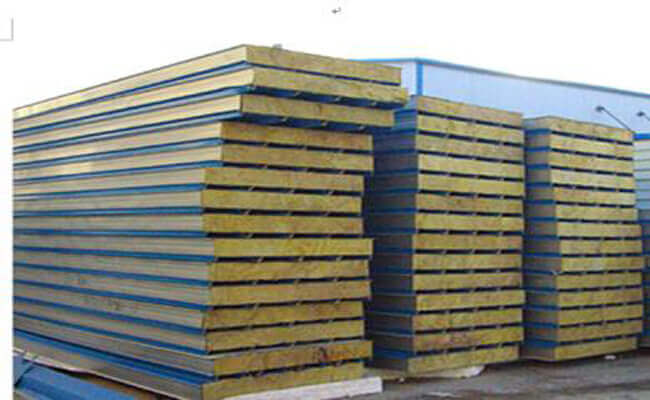Relatively recently, the building materials market has been replenished with new multifunctional large-sized wall and roof slabs, called sandwich panels. Their use in combination with frame technology for the rapid construction of residential, industrial and commercial buildings has led to a significant reduction in installation work.
The three-layer design of sandwich panels consists of a layer of insulation and a rigid double-sided lining, connected by cold or hot pressing. As a filler for panels, materials such as mineral wool, polystyrene foam or polyurethane foam have been widely used.

Sandwich wall panels based on mineral wool are a domestic representative of a new building material, manufactured on Italian-made equipment using imported high-quality raw materials. The filler of the panel is mineral wool made from volcanic rock – basalt with the addition of synthetic fiber. Basalt wool has a transverse orientation of fibers in the form of lamellas, which significantly increase the hardness of the panels. It has high coefficients of heat and sound insulation, resistance to deformation under the influence of temperature contrasts.
On both sides, the insulation layer is covered with a profiled galvanized sheet, which has a special polymer coating on the outside, which improves, in addition to appearance, protective functions – minimizes the impact of precipitation and sunlight, and protects from mechanical damage. The color scheme of the coating corresponds to the international RAL catalog, it is made in 5 primary colors and their shades. DAU glue (Germany) is used for gluing structural parts.
Production capacities allow to produce wall sandwich panels with several types of profiling and three types of locks: classic – improves the fire resistance of the structure, energy-saving – increases tightness, hidden – is responsible for thermal insulation.
The advantages of sandwich panels are:
- environmental friendliness, non-toxicity;
- hygiene, safety for humans and the environment;
- high rates of heat and sound insulation;
- a significant reduction in the construction or repair of buildings;
- no need for additional surface finishing;
- fire resistance (fire safety);
- high strength and lightness of the panel construction;
- large size;
- the possibility of construction at any time of the year;
- ease of transportation;
- no excessive load on the foundation;
- low price in comparison with analogues of wall materials.
Sandwich panel market: an opportunity to build quickly, cheaply, warmly and beautifully
Pro-Consulting analyzed the sandwich panel market in Ukraine for the period 2018-2019. Marketing research of the market allowed to determine its main parameters, identify factors of influence and development trends. A ready-made analysis of the sandwich panels market in Ukraine can be purchased on the company’s website.
Sandwich panels are widely used in construction due to their high insulation performance, fire resistance and sufficient strength combined with low specific gravity. The panels are quickly mounted on a metal frame, which reduces the time and cost of erecting structures for various purposes in this way: cottages, shops, warehouses, change houses, roadblocks and others. The most popular on the sandwich panel market in Ukraine are panels filled with polyurethane foam, which are used as:
- external hydro- and thermal insulation of walls and roofs of industrial and residential buildings;
- wall elements of structures of prefabricated structures;
- thermal insulation of refrigerators and other refrigeration transport equipment.
Thus, the volume of the sandwich panels market in Ukraine depends on the state of affairs in the indicated segments of the construction and manufacturing industries.

If you are looking for statistics on your market, as well as forecasts of its development, contact Pro-Consulting – we guarantee an independent assessment of your market
Monitoring of the sandwich panel market in Ukraine shows that prices on it depend on the following factors:
- filler composition;
- panel thickness;
- design;
- bearing capacity of the material;
- the level of competition among manufacturers;
- exchange rate.
